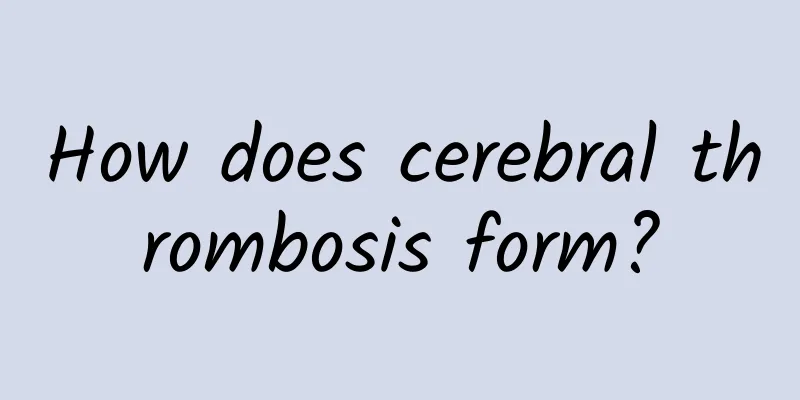How does cerebral thrombosis form?

|
Cerebral thrombosis is now a very common disease. Cardiovascular and cerebrovascular diseases are currently a great threat to our human health. Its incidence rate has been getting higher and higher among the middle-aged and elderly population. This has a lot to do with our daily life. Now that living conditions are better and the material level has been greatly improved, people nowadays are becoming more and more prone to illness. How do cerebral thrombosis occur? Everyone should know about cerebral thrombosis. There should be many patients with cerebral thrombosis around us. Cerebral thrombosis will not only have a great impact on the patient, but also the whole family will be hit hard. Everyone should take timely prevention measures and know how cerebral thrombosis is formed. Three major causes of cerebral thrombosis 1. Hemodynamic changes The regulation of cerebral blood flow is affected by many factors. Changes in blood pressure are an important factor affecting local blood volume in the brain. Due to lesions in the blood vessels themselves, stenosis of the lumen, and failure of the automatic regulation function, blood supply to local brain tissue may be impaired. 2. Vascular Disease The most important and common vascular disease is atherosclerosis, followed by cerebral arteriosclerosis associated with hypertension. Others include vascular developmental abnormalities, such as congenital aneurysms and cerebral vascular malformations, and vasculitis, such as endarteritis caused by infectious rheumatic fever, tuberculosis, leptospirosis, syphilis, etc. 3. Changes in blood composition The inner membrane of the vascular lesions is rough, making it easy for platelets in the blood to adhere, accumulate, and release more chemical substances such as serotonin. The increase in the content of lipoprotein, cholesterol and fibrinogen in the blood components can increase blood viscosity and slow down blood flow. Clinical manifestations Before the onset of the disease, the patient had symptoms such as numbness of limbs, difficulty in movement, slurred speech, dizziness, and blurred vision. The disease often occurs during sleep or in the morning. The affected limb is weak or cannot move, speech is slurred or aphasic, and the patient chokes when drinking water. Most patients have loss of consciousness or mild impairment. Facial nerve and hypoglossal nerve paralysis, nystagmus, weakened or enhanced muscle tone and abdominal reflexes, positive pathological reflexes, weakened or absent abdominal wall and cremaster reflexes. Mild symptoms of cerebral thrombosis include inflexibility of limbs on one side, numbness of senses, and aphasia. Severe cases may lead to coma, incontinence, and even death. However, due to different locations of occurrence, the symptoms of cerebral thrombosis are also different. 1. Internal carotid artery system (1) Internal carotid artery system, that is, when the lesion occurs in the internal carotid artery, the symptoms of cerebral thrombosis are clinically manifested as "three hemiplegia", namely hemisensory disturbance, and hemianopsia. It may also be accompanied by psychiatric symptoms. The dominant half of the lesion may also have varying degrees of aphasia, apraxia and agnosia. There may also be characteristic blindness in the affected eye accompanied by contralateral hemiplegia called crossed amaurosis, oculomotor nerve palsy, and decreased retinal artery pressure. (2) Anterior cerebral artery This is also a symptom of cerebral thrombosis. Because the anterior communicating artery provides collateral circulation, proximal blockage may be asymptomatic; when the peripheral branches are affected, the medial surface of the frontal lobe is often invaded, and lower limb paralysis often occurs, which may be accompanied by cortical sensory disorders and urination disorders in the lower limbs; deep perforating branch blockage affects the anterior branch of the internal capsule, and central facial and tongue paralysis and mild paresis of the upper limbs often occur. When bilateral anterior cerebral artery occlusion occurs, mental symptoms may occur accompanied by bilateral paralysis. (3) When the main trunk of the middle cerebral artery is occluded, there will be three hemiplegia symptoms, and aphasia will also occur when the dominant hemisphere is lesioned. This is the most common site of blood clots. We all need to know more about how cerebral thrombosis is formed. After all, there are already many patients with cerebral thrombosis, which has a lot to do with our daily lifestyle. Therefore, we must prevent this disease in our daily lives, develop good habits, and avoid cardiovascular and cerebrovascular diseases. |
<<: Sequelae of cerebral infarction
Recommend
What anti-inflammatory medicine should I take for pus discharge from the penis
The genitals are the main reproductive organ of m...
Can I eat fruit if I have vomiting and diarrhea?
Most people have experienced the pain of diarrhea...
What to do if baby's finger has thorns
The baby's skin is very tender and smooth, bu...
What are the dental procedures?
Dentistry is a very important medical department ...
Late stage symptoms of non-gonococcal disease
Non-gonococcal urethritis refers to non-gonococca...
Can neonatal hypoxic-ischemic encephalopathy cause sequelae?
As the name suggests, neonatal hypoxic ischemic e...
What are the benefits of soaking your feet in dried mugwort leaves?
Mugwort has been widely used among our people sin...
Pregnant women should not drink Yinchen water
Artemisia capillaris is a common traditional Chin...
These acupuncture points on the body can actually save lives, you must know them for your health!
In daily life, are we all at a loss when faced wi...
Symptoms of Ringworm
In the daily lives of most of us, we often encoun...
What are the treatments for ankle bone hyperplasia?
Many people suffer from illness in their lives. D...
Specific medicine for lumbar disc herniation
Lumbar disc herniation is a relatively common dis...
Nausea after taking birth control pills
Contraceptive pills have certain side effects. So...
What is the best medicine for cerebral thrombosis?
Cerebral thrombosis can be said to be a very comm...
What should I do if there are bacteria in leucorrhea examination?
If a woman finds bacteria in her leucorrhea durin...









